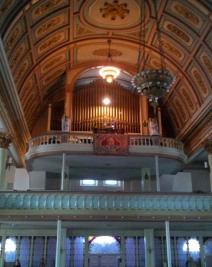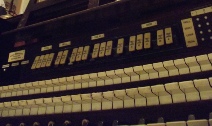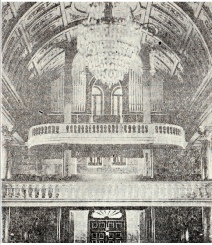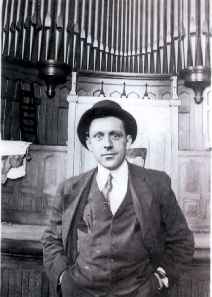
Pipe Organ Maintenance & Restoration Services
Proudly serving customers throughout New England since 2010



Organ in second tier rear gallery present day
Console in fixed central position in gallery. Organists back to the rail
Great and Swell manuals, coupler tabs and blind piston indicator lamps
History -
In 1896, Sacred Heart church moved from its first church building, the former Methodist church into the brand new church built of imported Quebec granite where it is located to this day. One of the only items in the church not imported from its members native land of Quebec, was the coal fired steam boiler built in Worcester.
The pipe organ was built and installed by organ builder E. B. Brodeur, of Quebec in 1896. It’s building and design were overseen by the churches organist Professor Boulay. It is noted in the parish history book that many innovations were made in the design and construction of this pipe organ and goes on to state that patents for some elements were applied for. Our search for these patent records continues. The grand and well ornamented sanctuary with its faux marble, gilded wood barrel vault ceiling, double balcony and long center aisle and side aisles required an instrument of equal proportions to support the musical portion of the liturgy. An educated guess based on a few available stop lists of some of Brodeur’s other instruments from the same time and an inventory of the pipe work in the instrument leads us to believe that the original organ would have been of three manuals and pedal, with mechanical and possibly tubular pneumatic action playing from a detached console.
By the late 1920’s, the mechanisms of the organ were showing their age so in 1930 the church had a major rebuild of the organ carried out. A paragraph in the parish history book carries on a bit of misinformation that seems to date back that far, quoting “In 1929, Msgr. Desrochers purchased the present electric organ from a company in Canada. A Mr. Arthur Morrissette came to Webster to assemble and install it at a cost of over $10,000.00. It was to be played for the Ordination, in June 1930, of two Parishioners, Father Oliva Gevry and Father Edward Authier.”
The extent of work done in 1930 was enlargement of the organ case connecting the original two separate cases into one large case as seen today. Replacement of the wind chests with electro pneumatic ventil chests, a new electro pneumatic console, an electric blower in the basement, building of a choir box and the addition of several new ranks of pipes to enlarge the organ. While Morrissette did originally come from Canada, he was resident of Webster and ran an organ building firm out of Westfield MA. Having worked for Casavant and possibly at the Westfield Skinner plant, it is no surprise to find similarities to instruments by those two builders blended into the organ at Sacred Heart
By the late 1970’s, the organ was again showing its age and having problems. The parish launched into a fundraising campaign to again have their treasured pipe organ rebuilt. The organ was releathered twice over the course of the next dozen years, once with rubber perflex that failed within a few years and then with proper leather. A few tonal revisions were carried out in 1982 in the form of the replacement of the great trumpet and mixture, the addition of a 16’ pedal trumpet and choral bass 4’ and a 4’ principal in the swell.
After years of great expense and continued difficulty and unreliability of the mechanism, the organ was finally silenced in the late 90’s by a pastoral decision, and the electronic organ was purchased for the church.
What should have been a death knell for this historic instrument, instead sealed it in a time capsule where it would languish for over a dozen years waiting to once again move the church with it’s heavenly voice.
Current Work-
In late 2012, after nearly fifteen years, the reservoirs of the organ were once again filled with life giving wind. Only a few problems remain in the organ mechanisms and are being addressed as finances allow. The organ was pitched and tuned in the Spring of 2013 in time for Holy week. The outpouring of financial support from the parish to pay for the tuning far surpassed the goal and has allowed restoration and repair work to begin on the organ.
While the wind chests and playing mechanisms are for the most part in reasonable shape, the 1930 console is in need of major work to get it to 100% reliable condition. The dollar amount for that work is in the many thousands so small repairs and adjustments are continually made to keep the organ as close to fully functional as possible until such time that funds can be raised for the full rebuilding.
The reintroduction of the churches historic pipe organ to weekly and special liturgies has brought renewed interest in the music ministry and the instrument itself.
With the cantors and choir once again singing God’s praise from the top of the church and the grand and beautiful pipe organ supporting them, a strong connection is being formed with the many generations of faithful parishioners who built, maintained, and have rebuilt the church, it’s fittings and it’s magnificent pipe organ.
With regular care and maintenance, this pipe organ will play on for many generations to come continuing the legacy left to the church by the parishioners who sacrificed so much to see her built big and strong for their families and descendants.
To date, the great stop action primaries have been releathered, along with the Swell tremolo. The choir tremolo valve was fitted with a variable electronic driver, and both choir and swell expression motors have been fully rebuilt with releathered primaries, new rubber cloth on the main motors and new magnets. Additionally, the pedal bourdon unit chest was fitted with new leather gaskets on it;s magnet boards to replace original paper gaskets damaged by water some years ago.

Newspaper photo of the original installation circa 1896/7. Original windows and gas chandeliers also

Eusèbe B. Brodeur

Arthur Morrissette
(photo provided by a living relative)
Pedal
Resultant 32’
Pedal Diapason 16’
Bourdon 16’
Gedeckt 8’
Cello 8’
Choral Bass 4’
Trumpet 16’
(1-
Chimes
Couplers
Great to Pedal 8’
Swell to Pedal 8’
Swell to Pedal 4’
Choir to Pedal 8’
Swell to Great 16’
Swell to Great 8’
Swell to Great 4’
Choir to Great 16’
Choir to Great 8’
Choir to Great 4’
Great to Great 4’
Swell to Choir 16’
Swell to Choir 8’
Swell to Choir 4’
Choir to Choir 16’
Choir to Choir 4’
Pistons
Swell 1-
Great 1-
Choir 1-
Toe Studs
Great to Pedal
Swell to Pedal
Choir to Pedal
Sforzando
Pedal 1-
Indicator lamps
Generator
Crescendo
Sforzando
Piston lamps
Great 1-
Swell 1-
Choir 1-
Pedal 1-
Other
3 manual and pedal draw knob console located in second tier rear gallery.
Electropneumatic combination action.
Electropneumatic ventil windchests for manuals.
Electropneumatic unit chests for pedal

Sacred Heart of Jesus -
Stop List
Great
Open Diapason 8’
(Bass in facade)
Melodia 8’
Gemshorn 8’
(Bass in facade)
Dulciana 8’
Octave 4’
Koppel Flote 4’
Nazard 2 2/3’
Fifteenth 2’
Mixture III
Trumpet 8’
Chimes
Swell
Bourdon 16’
Open Diapason 8’
Stopped Diapason 8’
Salicional 8’
Vox Celeste 8’
Principal 4’
Flute D’Amour 4’
Violina 4’
Flautina 2’
Cornopean 8’
Oboe 8’
Vox Humana 8’
Chimes
Tremulant
Choir
Gamba 8’
Viol D’Orchestra 8’
Dulciana 8’ (celeste)
Traverse Flute 4’
Piccolo 2’
Clarinet 8’
Chimes
Tremulant
During an early test play of the organ after its nearly 15 year silence. Music Director, Kiel Krommer, Plays “The Summons”. This features the Choir Clarinet as a solo reed towards the beginning accompanied by swell stops, towards the end, Full great is heard as the great stop action was non functional and we rigged it to play everything as we worked out some bugs that day. No tuning had been done yet